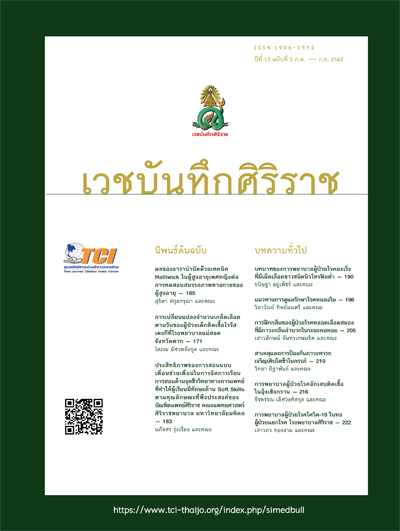สาเหตุและการป้องกันภาวะทารกเจริญเติบโตช้าในครรภ์
Main Article Content
Abstract
Fetal growth restriction means the condition in which the fetus is under normal growth. The causes may be from genetic factors, placental cause, underlying maternal diseases and other co- risk factors. Prompt diagnosis and early management can help to reduce the fetal mortality and morbidity and metabolic diseases in adult which includes hypertension, diabetes mellitus and dyslipidemia. Identifying the causes of feral growth restriction by history taking, physical examination, and laboratory tests of mothers during pregnancy can prevent the fetus from growth restriction. There is recently no evidence of aspirin to prevent fetal growth restriction. Daily proper activity during pregnancy can reduce the risk of fetal growth restriction. The mothers could have healthy food, drinking plenty of pure water at least 6-8 glasses per day, adequate sleep, avoid alcohol drinking, smoking and drug abuse. The mothers could have regular antenatal care for early diagnosis of abnormal fetal growth and proper management.
Article Details
References
2. Battaglia FC, Lubchenco LO. A practical classification of newborn infants by weight and gestational age. J Pediatr. 1967;71(2):159-63.
3. Seeds JW, Peng T. Impaired growth and risk of fetal death: is the tenth percentile the appropriate standard? Am J Obstet Gynecol. 1998;178(4):658-69.
4. Zhang J, Mikolajczyk R, Grewal J, Neta G, Klebanoff M. Prenatal application of the individualized fetal growth reference. Am J Epidemiol. 2011;173(5):539-43.
5. Manning FA. Intrauterine growth retardation. In: Fetal Medicine: Principal and Practice, Appleton & Lange, Norwalk, CT 1995. p. 137.
6. Lunde A, Melve KK, Gjessing HK, Skjaerven R, Irgens LM. Genetic and environmental influences on birth weight, birth length, head circumference, and gestational age by use of population-based parent-offspring data. Am J Epidemiol. 2007;165(7):734-41.
7. Bahado-Singh RO, Kovanci E, Jeffres A, Oz U, Deren O, Copel J, et al. The Doppler cerebroplacental ratio and perinatal outcome in intrauterine growth restriction. Am J Obstet Gynecol. 1999;180(3 Pt 1):750-6.
8. American College of Obstetricians and Gynecologists. Intrauterine growth restriction. ACOG Practice Bulletin Number12. January 2000.
9. Rodger MA, Gris JC, de Vries JIP, Martinelli I, Rey E, Schleussner E, et al. Low-molecular-weight heparin and recurrent placenta-mediated pregnancy complications: a meta-analysis of individual patient data from randomised controlled trials. Lancet. 2016;388(10060):2629-41.
10. Berghella V. Prevention of recurrent fetal growth restriction. Obstet Gynecol. 2007;110(4):904-12.


